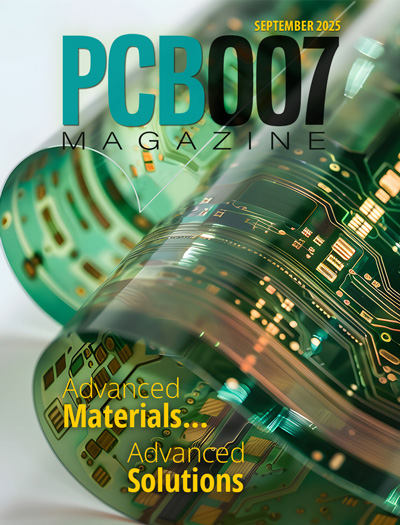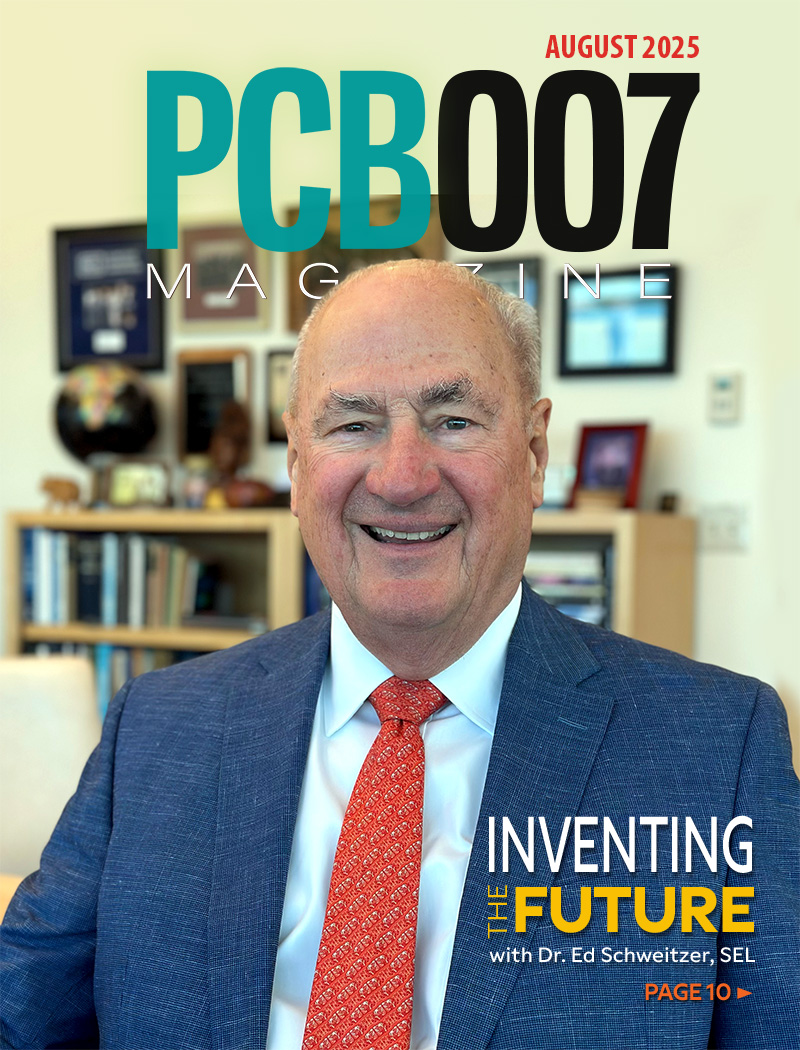-

- News
- Books
Featured Books
- pcb007 Magazine
Latest Issues
Current Issue
The Legislative Outlook: Helping or Hurting?
This month, we examine the rules and laws shaping the current global business landscape and how these factors may open some doors but may also complicate business operations, making profitability more challenging.

Advancing the Advanced Materials Discussion
Moore’s Law is no more, and the advanced material solutions to grapple with this reality are surprising, stunning, and perhaps a bit daunting. Buckle up for a dive into advanced materials and a glimpse into the next chapters of electronics manufacturing.

Inventing the Future With SEL
Two years after launching its state-of-the-art PCB facility, SEL shares lessons in vision, execution, and innovation, plus insights from industry icons and technology leaders shaping the future of PCB fabrication.
- Articles
- Columns
- Links
- Media kit
||| MENU - pcb007 Magazine
Flex Standards Update With Nick Koop
November 21, 2019 | Andy Shaughnessy, Design007 MagazineEstimated reading time: 1 minute
This month, I interviewed Nick Koop—director of flex technology at TTM Technologies, a veteran “flex guy” and instructor, and a leader of several IPC flex standards committees. Nick provides an update for the committees he’s involved with and discusses some of the challenges that he sees as more designers enter the world of flex.
Andy Shaughnessy: Nick, tell us a little about your background and your work with flex and rigid-flex circuits at TTM.
Nick Koop: I’ve worked in the flex and rigid-flex world since 1985 where my roles have ranged from process engineer to design engineer to general manager of a factory. And I’ve been with TTM since 2013. It has been a great experience working with such a wide range of customers and programs, solving problems that lead to success for our customers.
Shaughnessy: You’re the vice-chair of the Flexible Circuits Committee and co-chair of the 6013 Subcommittee. Give us some updates on the flex committees.
Koop: All of the flex specifications are being reviewed on an ongoing basis. We are close to releasing new versions of IPC-2223 and IPC-6013. They will include more information on microvias, finished copper thickness, and other member-requested updates. I would expect that to happen by early 2020. The supporting material specifications and test methods are also under review. In addition, there is work happening on the T-50 Terms and Definitions Guideline, which is in the middle of a substantial update. So, there is a lot happening on all fronts.
Shaughnessy: We talk to a lot of rigid board designers who are being forced into flex design. Usually, they start with flex standards, and then hopefully, they will call a flex board shop. What advice would you give any rigid folks moving into the flex world?
Koop: We are also seeing dramatic growth in flex use driven by several factors; space, weight, reliability, and cost being some of the most common. Flex provides a lot of advantages over a rigid board and discrete wiring. My initial advice would be to gain an understanding of the similarities and differences. The key differences are unique materials and a variation in material movement, which can impact alignment.
To read this entire interview, which appeared in Flex007 in the September 2019 issue of Design007 Magazine, click here.
Testimonial
"Your magazines are a great platform for people to exchange knowledge. Thank you for the work that you do."
Simon Khesin - Schmoll MaschinenSuggested Items
Trouble in Your Tank: Understanding Interconnect Defects, Part 1
11/04/2025 | Michael Carano -- Column: Trouble in Your TankThis month, I’ll address interconnect defects (ICDs). While this defect continues to rear its ugly head, don’t despair. There are solutions, most of which center on process control and understanding the relationship of the chemistry, materials, and equipment. First, though, let’s discuss ICDs.
WestDev Announces Advanced Thermal Analysis Integration for Pulsonix PCB Design Suite
10/29/2025 | WestDev Ltd.Pulsonix, the industry-leading PCB design software from WestDev Ltd., announced a major enhancement to its design ecosystem: a direct interface between Pulsonix and ADAM Research's TRM (Thermal Risk Management) analysis software.
Designers Notebook: Power and Ground Distribution Basics
10/29/2025 | Vern Solberg -- Column: Designer's NotebookThe principal objectives to be established during the planning stage are to define the interrelationship between all component elements and confirm that there is sufficient surface area for placement, the space needed to ensure efficient circuit interconnect, and to accommodate adequate power and ground distribution.
Episode 6 of Ultra HDI Podcast Series Explores Copper-filled Microvias in Advanced PCB Design and Fabrication
10/15/2025 | I-Connect007I-Connect007 has released Episode 6 of its acclaimed On the Line with... American Standard Circuits: Ultra High Density Interconnect (UHDI) podcast series. In this episode, “Copper Filling of Vias,” host Nolan Johnson once again welcomes John Johnson, Director of Quality and Advanced Technology at American Standard Circuits, for a deep dive into the pros and cons of copper plating microvias—from both the fabricator’s and designer’s perspectives.
Nolan’s Notes: Tariffs, Technologies, and Optimization
10/01/2025 | Nolan Johnson -- Column: Nolan's NotesLast month, SMT007 Magazine spotlighted India, and boy, did we pick a good time to do so. Tariff and trade news involving India was breaking like a storm surge. The U.S. tariffs shifted India from one of the most favorable trade agreements to the least favorable. Electronics continue to be exempt for the time being, but lest you think that we’re free and clear because we manufacture electronics, steel and aluminum are specifically called out at the 50% tariff levels.


